I would rate red mites as being one of the biggest problems you will face when keeping chickens. Red Mites live in the cracks of chicken houses (typically under perch ends) coming out at night, crawling onto your birds for a feed.
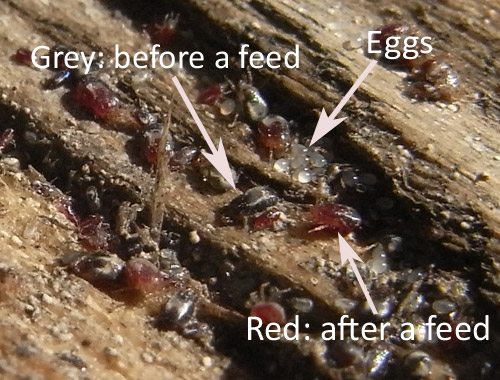
Macro shot of Red Mite in a crack on a perch. These were disturbed after a treatment with Poultry Shield.
They start off as very small greyish-white mites that swell up into red coloured mites after a feed and at their biggest are only 1mm so small numbers of them can be hard to spot unless you know what to look for.
You will often find a grey ash like deposit around perch ends which is where the mites have been and if you lift the perch, you will see clumps of mites.
Red Mite in chickens’ houses are active during the warmer months, usually May to October and will become dormant over the winter. They multiply at an incredible rate: their life cycle is just 7-10 days. In other words from hatching from an egg to being an adult laying hundreds of eggs takes just a week if conditions are right.
Be Proactive.
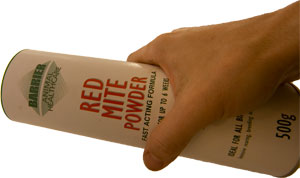 The best course of action is to check for red mite routinely when you clean your chicken house out and use some preventative treatment to the house before they get a hold. You will get to know the places to look and once you have found small numbers of them, you can treat the house to keep numbers under control. See my ‘preventative measures’ below
The best course of action is to check for red mite routinely when you clean your chicken house out and use some preventative treatment to the house before they get a hold. You will get to know the places to look and once you have found small numbers of them, you can treat the house to keep numbers under control. See my ‘preventative measures’ below
Are there Red Mite in your Chicken House?
People normally discover Red Mite when they are over-run by them. When hens are being bitten, they can refuse to go in to roost at night, they will become anaemic and their combs will go pale. They will often stop laying and you may find red blood stains on eggs (squashed Red Mites). Eventually, you will start to see losses in the flock.
Checking for Red Mite in Chickens Houses
Red Mite will hide away in the daytime but can often be seen if you lift perches, examining the ends. They will usually come swarming out if you treat the cracks with Poultry Shield but by far the easiest way to check to see if there are red mite is to take a piece of white kitchen roll and to rub it along the underside of the perch when your hens are roosting (in the dark). Look at the tissue and if there are Red Mite heading back from their feed, they will be squashed on the kitchen roll as streaks of blood.
Getting rid of Red Mite
It is very hard to get rid of them completely so it is often better to get the numbers down and then find a way of keeping them down that doesn’t involve you spending hours on cleaning the house out. There are lots of different treatments that people use, some more effective than others but I will focus on what I do and have found to be the most successful for me.
If you haven’t got red mite and the weather is warm enough for them (May to October in the UK) then skip step 1 and go straight to step 2. Preventative Measures.
1. Getting rid of an infestation.
If you find lots of red mite in the coop, it’s time for a big clean up that will take a couple of hours initially, then an hour every 5 to 7 days for at least 2 more weeks.
The products I have found to work the best (that are relatively safe) are Poultry Shield and Diatom. These two are not ‘knock down’ products as such, they do take a little while to work but are none the less very effective. I also use Red Mite Powder on the hens themselves to help them through the night when the Mites are active.
You can BUY Poultry Shield from Amazon Here.
Here is what I do with the Poultry Shield.
- Remove all birds from the house.
- Strip the house down as much as possible.
- Clean the house out – be careful where the bedding is going as red mite live for 6 months without a feed and will find a new home If they can. Ideally seal the bedding in bin bags or burn.
- Mix up as many watering cans of poultry shield mixture as is needed, as per the instructions on the label 1 part to 9 parts water.
- ‘Water’ all cracks in the chicken house, concentrating where there are perch ends and concentrations of red mite.
- Leave to soak for 15 minutes
- Red mites will be coming out. Cover them and the cracks with poultry shield again.
- Wait 15 minutes
- Hose out the house, concentrating on getting the pressure jet into the cracks and so on.
- Leave the house to dry.
Poultry Shield is a mild detergent and ‘washes’ the waxy coat off the red mites. It is also good for removing organic matter from the hen house so is useful for cleaning. I wouldn’t be without this!
After using the Poultry Shield, when the house is dry, I use Diatom. Diatom is made of micro skeletons of fossilised remains of diatoms. These were once a kind of algae found in water. They are microscopically sharp and pierce the outer waxy coating of the mites which causes them to dry out and die.
The second step also double up as my ‘preventative’ measures if you haven’t yet got a bad infestation
You can BUY Diatom from Amazon HERE
2. Preventative Measures
- Dust the ends of the perches / nest boxes and where ever else you found concentrations of red mites when cleaning.
- Rub as much into the perches as you can. Red mite will avoid the diatom and will crawl around it if they can, so make sure they have to crawl through it to get a feed.
- Repeat every couple of days for as long as you see signs of red mite in the coop.
Repeat the whole cleaning process if there are still lots of mites in 5 to 7 days. You will find you might not need to spend as long on the washing as there won’t be as many mites.
Very Important: Make sure you repeat it before 7 days so that the mites don’t have a chance to lay more eggs. A few mites become a lot in a very short space of time!
If you have a felt roof on your chicken house and they get underneath, it is usually impossible to get rid of them without removing the felt, cleaning and re-felting. My page on Chicken Houses gives more information.
Finally, I will dust the hens down between their feathers with Red Mite Powder to give them some respite during the night when the mites are active.
Beware of what you read!
There is a lot of information written about these troublesome ectoparasites on the internet these days, much of it re-written and re-spun. When I started writing about them, there was little available online. Strangely, some small errors that I had introduced on my page that I corrected in an update pop up frequently on other websites. Running a Google image search often uncovers companies that have used my copyrighted images! I make regular checks to try to stop this from happening.
If you wish to learn more about red mite then I would encourage you to read the guide to red mite on poultrykeeper.com. This is a reliable source of information and is regularly updated.

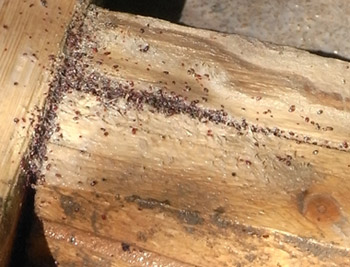

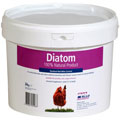

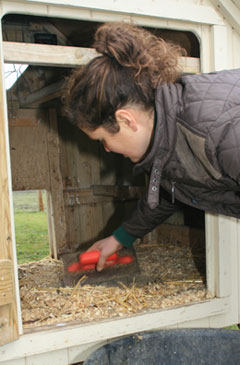
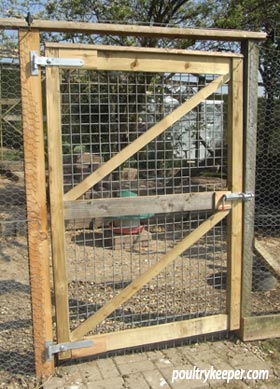
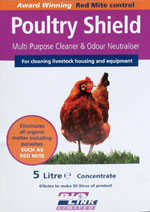
Can rodents such as gerbils which live indoors in plastic and glass tanks, with wood chippings for bedding, contract red mites? UK based, had gerbils for decades, have never come across gerbils having mites in their accommodation / on themselves. Not sure what things to do as treatment are possible – not had rodents and chickens at the same time before. The chickens come in the house (behind our backs) and the gerbils go in the garden on a nice day, plus are handled by us, so are ‘exposed’ to a degree.
Well today’s the day,I have discovered red mite in my coop and boy are my girls suffering,(as well as me)probably going to take hours to sort out the coop but has to be done,I am armed with everything possible,and yes I will get them.i have one girl that is really pale,but hopefully have caught it in time.will post how I get on and with a bit of luck would have got on top of the problem,if not i don’t know what to do next,any advice would be grateful as I have had enough of these things as they are getting in my hair too ! Anybody know how I can stop them getting in my hair it’s driving me crazy,thanks for any advice it would be most welcome.Help!!!
I had struggled with red mite for many years spending fortunes on powders and potions none seem to work for long. I have since had to move my hens just up a few fields last summer. I took my sheds to bits and creosoted inside and out and found that the mites do hate that. I kept doing it until they no more could be found and this took 3 coats each side they come out of everywhere! I thought I had cracked it but they are back now and I could cry. I can’t take my sheds down again but I thought if I can thorougly clean out, then I may try the blow torch, rinse out, poultry shield, creosote inside and out then let dry, diatom then mite powder everything then re do in 5 days, keep this up until they are gone. I may try the red diesel idea and the lime? also i heard that the mites cant climb up the hens if you put vaseline on their legs so will try that. I will also dust the hens. Is there anything I’ve missed? I’ll try anything? It’s so heartbreaking. I have just lost 2 girls that were healthy before the odd one does look a bit pale but some of the other hens look great and are laying well. I have been keeping free range hens for about ten years and red mites have always been a problem in the summer. I hope one day there will be a miracle cure.
Be very careful with Creosote – it was banned for a reason 😉 I certainly wouldn’t be using red diesel – any chemical that comes into contact with the skin of the bird will be going into the bird and ultimately your eggs.
What you could try is fitting a perch using 10mm studding at each end that protrude out of the wall. Add a large washer held in place by 2 nuts half way along this. Mites have to crawl along this to reach the birds so smear Vaseline around each side of the washer. The mites will get stuck to it.
Every week, wipe the Vaseline off and put fresh on.
Make sure the hens bodies cannot touch the roof or sides of the house when perched (the reason for using studding to keep the perch ends 6″ or so away from the wall).
Are Red mites and Chiggers the same creature? Where do they come from initially?
No they are not. Red mite will get carried by wild birds and from bird to bird between coops.
is there anything i can dowse the chickens in thats not a powder? ideally can i fill a tub and dipped the chickens and ducks into a solution?
I am not aware of anything sorry.